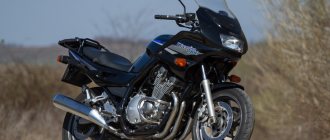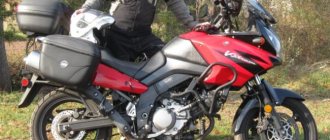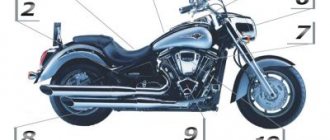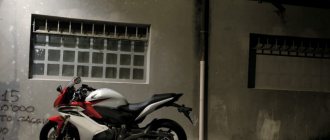BMW K1200LT
Model class : tourist
Years of production/sales : 1998-2009
BMW K1200LT model appeared in 1998, replacing the obsolete BMW K1100LT. Unlike its predecessor, the updated version has received many changes and improvements:
- Completely new appearance and plastic design, integrated panniers.
- New cast aluminum frame.
- New wheels of standard size (17').
- New engine of increased volume (1172 cc) with a new version of the injection system (Motronic MA 2.4) and electronically controlled throttle.
- New EVO braking system with fully integrated ABS II (from autumn 2000).
- Possibility of reversing (due to starter reverse).
- Telelever suspension at the front.
Otherwise, the BMW K1200LT model is a classic BMW K-series touring motorcycle with an in-line 4-cylinder horizontal liquid engine, cardan drive, proprietary BMW Telelever and Paralever suspensions, ABS and a whole range of various touring options - cruise control, built-in saddlebags, heating seats and handles, multimedia, on-board computer, electrically adjustable windshield, etc.
The BMW K1200LT model existed until 2009, after which it was discontinued, but did not receive further development. In 2011, a completely new model, the BMW K1600GT, was introduced, which is considered to be a successor to the BMW K1200LT, but both motorcycles are radically different from each other. Analyzing the history of BMW touring motorcycles, it should be noted that early BMW models had many of the features of touring motorcycles in the Honda Gold Wing style, but over time there was a move away from the concept of luxury tourers towards a sport-touring layout.
Thus, the BMW K1200LT model became the latest in the “luxury tourer” class of the BMW motorcycle line.
Motorcycles BMW K 1200 LT
The BMW K1200LT motorcycle is the embodiment of comfort, lightness, luxury quality parts and assembly at an affordable price. The model was created for those who value space and speed, who are used to traveling in comfort and at the same time not depending on others.
The BMW K1200LT first appeared at the Cologne exhibition in the fall of 1998, and mass production began in 1999. This model replaced the K 1100 LT, which was a serious competitor to the Japanese Honda Gold Wing. In the year of mass production, it immediately entered the TOP of the best bikes in its segment and has still not lost ground, despite its advanced age.
From 1999 to 2001, the bike topped the top ten luxury sports tourer models.
In 2000, the motorcycle was slightly modernized, in particular, this affected the braking system. The bike received a new integral ABS and electro-hydraulic boosters.
The K1200LT was originally designed for long-distance roads that require increased comfort for those who travel frequently and extensively. The bike is literally crammed with electronics, has a well-balanced body kit and, with good care, requires virtually no investment.
At the beginning of 2000, restrictions on the maximum possible power of 100 hp were lifted, and in 2004 the BMW K1200LT was again upgraded and received 116 hp, as well as additional electronics for more comfortable driving. The weight of the motorcycle remained the same, 343 kg, but the bike retained phenomenal handling and lightness.
In general, the BMW K1200LT motorcycle was produced for 10 years and the last copy rolled off the assembly line in 2009. Subsequently, it served as the basis for the company’s no less legendary brainchild - the BMW GTL 1600. Despite its advanced age, the bike is considered a “Limousine” among motorcycles. Luxurious, reliable and at the same time sportily dynamic and easy to drive, safe and powerful, it still occupies a leading position in the world motor markets.
The BMW K1200LT is a very reliable bike that can cover more than one thousand km. He holds the record for long distance travel. Well-known among bikers, D. Petrukhin rode 250 thousand km on such a motorcycle from 2004 to 2014. He has visited more than 150 countries, and his bike has never let him down.
BMW K1200LT, 1999, was produced with limited power. The ban was lifted only after 2000. The braking system was also significantly different compared to the complete modernization of the motorcycle in 2004, when the bike received not only integrated ABSII, but also the ability to adjust and heat the seats, as well as heated grips, an updated rear suspension and an electro-hydraulic stand, which is easily retracted by simply pressing a button. In 2004, the BMW K1200LT received the ability to control reverse gear.
Brief history of the model
- 1998 – start of production and sales of BMW K1200LT.
- autumn 2000 - the BMW K1200LT model receives a fully integrated braking system (ABS II).
- 2004 - the model receives a new 116 hp engine. and 120 Nm of torque, new shock absorbers in the suspension, an electro-hydraulic step and xenon headlights. The gearbox gears were also changed, which helped reduce the noise of this unit. Motorcycles of this generation are distinguished by two-tone coloring and front fender design.
- 2009 is the last year of production of the BMW K1200LT.
Specifications
Technical characteristics of BMW K1200LT:
| Model | BMW K1200LT |
| Motorcycle type | tourist |
| Year of issue | 1998-2009 |
| Frame | aluminum |
| engine's type | 4-cylinder in-line, horizontal |
| Working volume | 1172 cc |
| Bore x Stroke | 70.5x75 mm |
| Compression ratio | 10.8:1 |
| Cooling | liquid |
| Number of valves | DOHC, 4 valves per cylinder |
| Fuel supply system | Bosch Motronic MA 2.4 injector |
| Ignition type | electronic |
| Maximum power | 100 hp at 6750 rpm (116 hp at 8000 rpm - since 2004) 98 hp - special versions for Germany |
| Maximum torque | 115 Nm at 4750 rpm (120 Nm at 5250 rpm - since 2004) |
| Transmission | 5-speed |
| type of drive | cardan |
| Front tire size | 120/70 ZR17 |
| Rear tire size | 160/70 ZR17 |
| Front brakes | 2 discs, 320 mm (305 mm - up to 2000), 4-piston calipers (fully integrated ABS II) |
| Rear brakes | 1 disc, 285 mm, 4-piston caliper (Full Integral ABS II) |
| Front suspension | BMW Telelever, stroke - 102 mm |
| Rear suspension | pendulum BMW Paralever, stroke - 130 mm |
| Overall dimensions (LxWxH) | 2508 x 1080 x 1395 mm |
| Seat height | 770/800 mm (adjustable) |
| Gas tank capacity | 23.5 l (including reserve - 4 l) |
| Maximum speed | 197 km/h |
| Acceleration to 100 km/h (0-100) | 4.9 sec |
| Motorcycle weight (curb) | 378.5 kg |
BMW K1200LT: review from Autopilot magazine
BMW K1200LT In Russia, motorcycle buyers are special. Around the world, the most popular series of two-wheeled BMWs is GS, that is, Gelaende und Strasse, which can be translated into Russian as “off-road-street”. GS is a universal thing. If you want, drive around the city, ride along curbs and curbs (Moscow and St. Petersburg account for 95 percent of Russian sales of BMW motorcycles), if you want, ride through forests and ravines. GS everywhere by the way.
But this is not the case with the Russian motorcycle buyer. It took him a long time to make the purchase. From birth, that is, 35-40 years. It is quite possible that in his youth he owned a “Java” - a pack of cigarettes in his pocket and a motorcycle on the staircase, and in his more mature years he “vacuumed” the roads in a “Japanese”. Then prosperity came to the house. And if they are wealthy, they don’t smoke Java and don’t drive Czech Java, even if they like it. And they buy a motorcycle to make it sound. BMW sounds. Besides, neither Mercedes nor Audi, not to mention Lexus, make motorcycles.
Moreover, the most popular BMW motorcycle model in Russia is also the most expensive. This is K1200T. Look. Last year, BMW produced a record number of motorcycles - 93 thousand units, every twentieth was called LT (Luxury Tourer). In Russia, LT is every fifth BMW sold. For the 2004 season, the Elteshka was updated: the motorcycle became more powerful, faster and louder. The latter applies to speakers. And the motorcycle was equipped with all sorts of CD changers, heated steering wheels and seats, and cruise controls before. Russian dealers immediately order devices with the maximum configuration. They understand: it’s not children who buy a bicycle with the last money from a piggy bank.
The K1200LT is $31,500 and has a 387kg curb weight. I’m not the most advanced user, so I approached the LT, which was parked in the parking lot, not without trepidation. Internally, of course, I encouraged myself, but it was somehow scary to take this car off the step. By the way, at the end of the test, out of curiosity, I got on a 650 cc BMW - after the LT, honestly, a moped is a moped.
But the feeling of confidence appeared later, and at first I, maneuvering around the parking lot, paddled my feet on the ground. Although he remembered well the instructor’s advice: “Imagine that you are wearing white socks and there is dirt under your feet.” Empirically, it turned out that the more decisively I set off, the easier it is to control a heavy motorcycle. Actually, I forgot about its weight almost immediately. And I remembered only when I stopped at a traffic light. It is better not to tilt the motorcycle. If it starts to fall, it’s not easy to hold it, and lifting the LT, as they say, can only be done by two or three people.
Before I got behind the wheel of the grand tourer, I read reviews about it. People mostly talk about the LT with excitement, because reviews are often written by people who know how to recite press releases, but don't know how to ride a motorcycle. Therefore, they conclude that the presence of a CD player, FM tuner and on-board computer turns a motorcycle into a car. Rare nonsense. I realized this quickly. Automatic transmissions are not installed on motorcycles. There is an opinion that for the sake of the driver’s safety: they say, if the automatic transmission starts changing gears in a turn, then flying off the road will be as easy as shelling pears. So even if you are a millionaire three times over, you will have to work with the transmission manually, assisting the process with your left foot.
Whenever you stop, the motorcycle driver must place his feet on the ground, and on the LT also try to spread them wider for stability. The problem could be solved by installing side wheels, like on children's bicycles, but experts would probably say something about the difficulty of cornering.
There is one more important difference between a motorcycle and a car - the inability to talk on a mobile phone. During the test days, I wore BMW branded leather pants that cost $700. They are made from the leather of exclusively Alpine cows, processed using Cool Leather technology, and therefore, despite their black color, they do not bask in the sun, reflecting infrared rays. And also - the manufacturer is silent about this - a mobile phone in the pocket of these pants is completely inaudible, even indoors, as if it were lying under the pillow. You can put your phone in your jacket pocket. But speaking on the go, wearing a helmet, with both hands occupied, still doesn’t make it any easier. “Let the whole world wait!” - any other motorcyclist will say. But not the LT owner. He will go to a company service, where for $2000 he will be equipped with intercoms for the driver and passenger helmet to communicate with each other, listen to music and talk on a cell phone. The phone - without a choice, certainly Nokia - will lie in the glove compartment.
I listened to music on the go without any intercoms. The higher the speed, the louder the sound. True, I’ll be honest, it doesn’t matter what you hear. At 120 km/h it feels like it’s playing at the neighbors’ house, behind the wall of a panel house. You can guess the melody, but nothing more. In general, the sound of the system, even at moderate volume, does not amaze the imagination, but a motorcycle with music attracts attention. Everyone just stares at the rich (once on a BMW) slacker (once on a motorcycle). You stand in traffic and feel that people are watching. I didn’t want to maneuver through traffic jams in the LT. Knowledgeable people claim that this is a matter of habit. Train, they say, for two weeks - you will prance.
But it would be easier to get away from unnecessary views on LT, if there was room. Acceleration to “hundreds” takes 5.5 seconds. Moreover, up to 100 km/h it unscrews - albeit all the way - in first gear. At the same time, the “liter-two-hundred-four-cylinder” engine installed on the motorcycle makes it possible to calmly ride in fifth gear at 60 km/h and even accelerate - not very quickly, but quite noticeably.
The LT, of course, cannot be called a universal and indestructible machine: even in the city it strives to hit speed bumps with its belly, and on completely harmless potholes it punches the front suspension all the way, but no one buys such motorcycles for the rest of their lives.
The average Russian LT buyer will travel at best twenty thousand kilometers in three to four years, sell it for half the original price, and buy a new one. This year, the LT gets an electro-hydraulic center stand, split headlights and an electronic instrument cluster. An experienced eye can easily spot a new product. Dozens of Russians now have a reason to go to a motorcycle dealership, ride out on a K1200LT and show everyone that life is good.
Source : Autopilot magazine
Model review : BMW K1200LT









